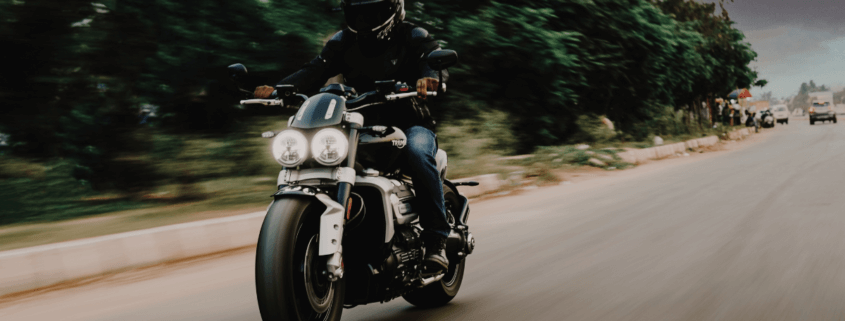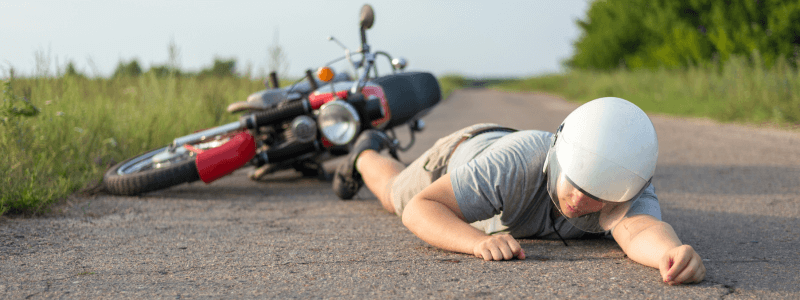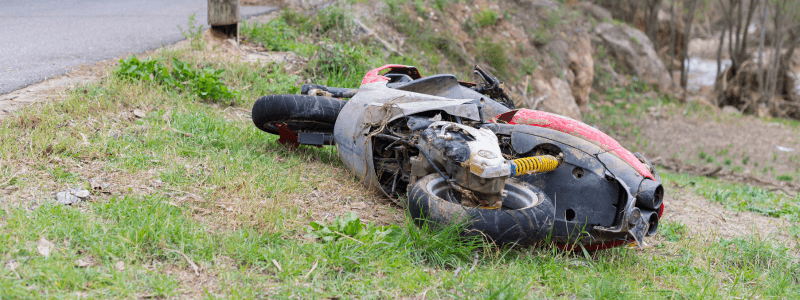Motorcycle accidents can be terrifying and traumatic. In the blink of an eye, your life can change in ways that you never imagined. However, it’s important to stay calm and focused after an accident, as there are certain steps you can take to help ensure the best outcome possible. Here are 5 things to do immediately after a motorcycle accident:
- Access Your Injuries and Call for Help
- Move to a Safe Location
- Exchange Information with Other Parties
- Document the Accident Scene
- Notify the Insurance Company
- Bonus: What NOT To Do After A Motorcycle Accident
- Bonus 2:
1. Assess Your Injuries and Call for Help
One of the most important things to do immediately after a motorcycle accident is to assess your injuries and call for help if necessary. Here are two important steps to follow:
Check for Injuries
The first thing you should do is check for any injuries to yourself or any other parties involved in the accident. Some injuries may not be immediately apparent, so be sure to look for signs of pain, discomfort, or bleeding.
If you are experiencing any pain or discomfort, it is important to take note of where the pain is located and how severe it is. This information can be helpful for medical professionals when they arrive on the scene.
If you notice any bleeding, try to apply pressure to the wound with a clean cloth or bandage. If the bleeding is severe, elevate the injured area and continue to apply pressure until help arrives.
Call 911 or Emergency Services
If you or anyone else is injured, call 911 or other emergency services immediately. It’s important to get medical attention as soon as possible to help prevent any further damage or complications.
When calling for help, be sure to provide your location and a brief description of the accident. If there are any hazards or obstacles that may impede emergency responders, such as downed power lines or a fuel leak, be sure to mention them as well.
While waiting for help to arrive, try to keep the injured person calm and comfortable. If they are conscious, reassure them that help is on the way and ask if there is anything you can do to help.
Remember, in the event of a motorcycle accident, time is of the essence. Assessing injuries and calling for help quickly can make a big difference in the outcome of the accident.
2. Move to a Safe Location
After assessing any injuries and calling for help, it’s important to move to a safe location. This can help prevent any further accidents or injuries. Here are two steps you should take:
Get Off the Road
If possible, move your motorcycle off the road and onto the shoulder or sidewalk. This will help to prevent any accidents with other vehicles. If you are unable to move your motorcycle, make sure to turn on your hazard lights to alert other drivers of your presence.
It’s important to remember that even if your motorcycle is still operable, it may not be safe to continue riding it. Check for any damage to the bike, including the handlebars, wheels, and frame. If any of these components are damaged, it’s best to call a tow truck to move your motorcycle to a safe location.
Secure the Accident Scene
If moving off the road isn’t possible, be sure to put up flares or other warning signs to help prevent other accidents. This will help to keep everyone safe. You can also use cones or reflective triangles to mark the accident scene and alert other drivers of the potential danger.
If there are any injuries, it’s important to keep the area around the injured person clear. This can help prevent further injuries and allow emergency personnel to access the injured person quickly. If you have any first aid training, you can provide assistance to the injured person while waiting for help to arrive.
Remember, staying calm and focused during an accident can help you make better decisions and keep everyone safe. Take a deep breath and remember that help is on the way.
3. Exchange Information with Other Parties
After moving to a safe location, exchange information with any other parties involved in the accident. This will help you to stay in contact and work out any necessary details. Here are two important steps to follow:
Gather Contact Information
It is important to gather the contact information of everyone involved in the accident. This includes their full name, phone number, and address. This will help you to stay in touch with them and exchange any necessary information. Additionally, it is important to get the contact information of any witnesses who saw the accident happen. This can be crucial if there is a dispute over who is at fault for the accident.
Collect Insurance Details
Collecting the insurance information of any other vehicles involved in the accident is critical. This will help to determine who is responsible for any damages or injuries. Be sure to get the name of the insurance company, the policy number, and the name of the insured. It is also a good idea to take pictures of the other driver’s insurance card, as well as their driver’s license.
Once you have gathered all of the necessary information, it is important to contact your own insurance company as soon as possible. They will be able to guide you through the process of filing a claim and help you to understand your coverage.
Remember to remain calm and courteous when exchanging information with the other parties involved in the accident. This can be a stressful and emotional time, but it is important to remain level-headed in order to ensure that everything is handled properly.
4. Document the Accident Scene
Documenting the accident can help you to remember important details and can also help with insurance claims. Here are a few additional steps that you can take to document the accident scene:
Take Photos and Videos
Take as many photos and videos of the scene as possible, including any damage to vehicles, road conditions, and any injuries that you or anyone else suffered. It is important to take photos and videos from different angles and distances to provide a complete picture of the accident scene. You can use your smartphone or camera to take these photos and videos.
In addition to taking photos and videos of the accident scene, you should also take photos of the surrounding area. This can include photos of nearby buildings, street signs, and traffic signals. These photos can provide important context for the accident and help to establish who was at fault.
Speak to Witnesses
Speak to any witnesses who may have seen the accident and take down their contact information. They may be able to provide valuable information that can help with insurance claims or legal actions. When speaking to witnesses, be sure to ask open-ended questions that allow them to provide detailed and accurate information. You should also ask for permission to record their statement, either in writing or on video.
It is important to speak to witnesses as soon as possible after the accident, as memories can fade quickly. If you are unable to speak to a witness at the scene of the accident, you can try to track them down later by using their contact information.
Make Notes
In addition to taking photos and videos and speaking to witnesses, you should also make detailed notes about the accident. This can include information such as the time and location of the accident, the weather conditions at the time of the accident, and any other relevant details. You should also make note of any injuries that you or anyone else suffered, as well as any damage to vehicles or property.
By taking these steps to document the accident scene, you can help to ensure that you have all of the information you need to file an insurance claim or pursue legal action if necessary. It is always better to have too much documentation than not enough, so be sure to take as many photos, videos, and notes as possible.
5. Notify Your Insurance Company
Being involved in a motorcycle accident can be a stressful and overwhelming experience. However, it’s important to stay calm and take the necessary steps to ensure your safety and protect your rights. Once you’ve done all the above steps, it’s important to notify your insurance company of the accident. Here are two important steps to follow:
Report the Accident
Reporting the accident to your insurance company is crucial, as it will help to speed up the claims process and ensure that your expenses are covered. Contact your insurance provider as soon as possible to report the accident and provide them with all relevant information, such as the date, time, and location of the accident, as well as any injuries sustained and damage to your motorcycle.
It’s important to note that failure to report the accident to your insurance company in a timely manner may result in denial of coverage or a reduction in the amount of compensation you’re entitled to receive.
Understand Your Coverage
Before filing a claim with your insurance company, it’s essential to understand your insurance coverage and any limitations or deductibles that may apply. Review your insurance policy carefully to ensure that you have the appropriate coverage for your needs, and take note of any exclusions or restrictions that may apply.
For example, some insurance policies may not cover accidents that occur while riding a motorcycle, or may have a high deductible that you’ll need to pay out of pocket before your insurance coverage kicks in. Understanding your coverage will help you to make informed decisions and avoid any surprises down the road.
By following these 10 steps, you can help to ensure the best outcome possible after a motorcycle accident. Remember to stay calm, assess any injuries, and document the scene before notifying your insurance company and taking the necessary legal actions.
Additionally, it’s important to seek medical attention as soon as possible after the accident, even if you don’t think you’ve been seriously injured. Some injuries, such as whiplash or traumatic brain injuries, may not appear immediately but can have serious long-term effects if left untreated.
Finally, consider consulting with an experienced motorcycle accident attorney to help you navigate the claims process and protect your legal rights. An attorney can help you to gather evidence, negotiate with insurance companies, and pursue legal action if necessary to ensure that you receive the compensation you deserve.
6. What NOT To Do After a Motorcycle Accident
Here are some things you should not do after a motorcycle accident.
- Leave the scene: Leaving the scene of an accident can result in criminal charges and can also harm your ability to recover compensation for your injuries.
- Admit fault: It is important to avoid admitting fault or apologizing for the accident, as this can be used against you later in the claims process.
- Delay seeking medical attention: Even if you feel fine after the accident, it is important to seek medical attention right away. Some injuries, such as internal bleeding or brain injuries, may not be immediately apparent.
- Fail to collect information: It is important to collect information from the other driver involved in the accident, including their contact and insurance information. You should also collect the contact information of any witnesses and document the scene of the accident, including taking photographs of the vehicles and any damage.
- Speak to insurance adjusters without a lawyer: Insurance adjusters may try to contact you shortly after the accident to obtain a statement. It is important to avoid speaking to them without first consulting with a lawyer, as they may try to use your statements to reduce your compensation.
- Sign a settlement agreement without consulting a lawyer: Insurance companies may offer a quick settlement to avoid a lawsuit, but it is important to consult with a lawyer before accepting any settlement offer. Once you accept a settlement, you may be barred from seeking further compensation.
- Post on social media: It is important to avoid posting about the accident or your injuries on social media, as insurance companies may use this information to dispute your claim.
7. Why Hire a Motorcycle Accident Attorney?
There are several reasons why you should consider hiring a motorcycle accident attorney after a crash:
- Legal expertise: Motorcycle accident attorneys have extensive knowledge of personal injury law, insurance policies, and court procedures. They can provide you with valuable legal guidance and help you navigate the complex legal system.
- Investigation: An attorney can conduct a thorough investigation of the accident, including collecting evidence, interviewing witnesses, and consulting with experts to determine liability.
- Maximizing compensation: An attorney can help you recover the maximum compensation possible for your injuries, including medical expenses, lost wages, pain and suffering, and other damages. They can negotiate with insurance companies and fight for your rights in court if necessary.
- Dealing with insurance companies: Insurance companies are notorious for offering low settlements to accident victims. An attorney can protect your rights and negotiate with the insurance company on your behalf, ensuring that you receive a fair settlement.
- Providing peace of mind: A motorcycle accident can be a traumatic and overwhelming experience. Hiring an attorney can provide you with peace of mind, knowing that your case is in capable hands and allowing you to focus on your recovery.
Overall, hiring a motorcycle accident attorney can help you navigate the complex legal system, maximize your compensation, and ensure that your rights are protected throughout the claims process. Contact Ryan L Hilts for more information.





